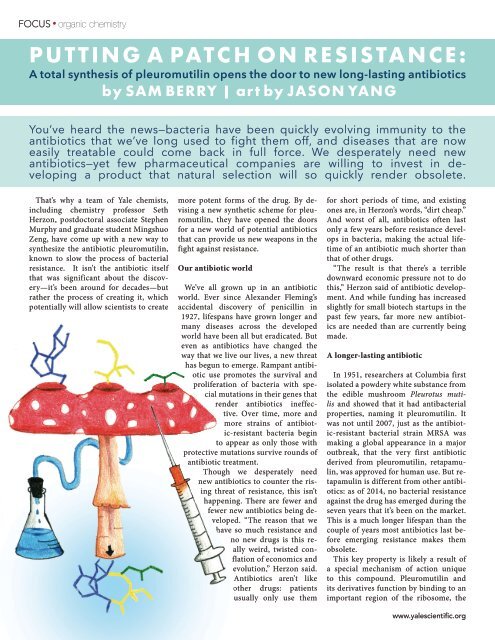YSM Issue 90.4
Create successful ePaper yourself
Turn your PDF publications into a flip-book with our unique Google optimized e-Paper software.
FOCUS<br />
organic chemistry<br />
PUTTING A PATCH ON RESISTANCE:<br />
A total synthesis of pleuromutilin opens the door to new long-lasting antibiotics<br />
by SAM BERRY | art by JASON YANG<br />
You’ve heard the news—bacteria have been quickly evolving immunity to the<br />
antibiotics that we’ve long used to fight them off, and diseases that are now<br />
easily treatable could come back in full force. We desperately need new<br />
antibiotics—yet few pharmaceutical companies are willing to invest in developing<br />
a product that natural selection will so quickly render obsolete.<br />
That’s why a team of Yale chemists,<br />
including chemistry professor Seth<br />
Herzon, postdoctoral associate Stephen<br />
Murphy and graduate student Mingshuo<br />
Zeng, have come up with a new way to<br />
synthesize the antibiotic pleuromutilin,<br />
known to slow the process of bacterial<br />
resistance. It isn’t the antibiotic itself<br />
that was significant about the discovery—it’s<br />
been around for decades—but<br />
rather the process of creating it, which<br />
potentially will allow scientists to create<br />
more potent forms of the drug. By devising<br />
a new synthetic scheme for pleuromutilin,<br />
they have opened the doors<br />
for a new world of potential antibiotics<br />
that can provide us new weapons in the<br />
fight against resistance.<br />
Our antibiotic world<br />
We’ve all grown up in an antibiotic<br />
world. Ever since Alexander Fleming’s<br />
accidental discovery of penicillin in<br />
1927, lifespans have grown longer and<br />
many diseases across the developed<br />
world have been all but eradicated. But<br />
even as antibiotics have changed the<br />
way that we live our lives, a new threat<br />
has begun to emerge. Rampant antibiotic<br />
use promotes the survival and<br />
proliferation of bacteria with special<br />
mutations in their genes that<br />
render antibiotics ineffective.<br />
Over time, more and<br />
more strains of antibiotic-resistant<br />
bacteria begin<br />
to appear as only those with<br />
protective mutations survive rounds of<br />
antibiotic treatment.<br />
Though we desperately need<br />
new antibiotics to counter the rising<br />
threat of resistance, this isn’t<br />
happening. There are fewer and<br />
fewer new antibiotics being developed.<br />
“The reason that we<br />
have so much resistance and<br />
no new drugs is this really<br />
weird, twisted conflation<br />
of economics and<br />
evolution,” Herzon said.<br />
Antibiotics aren’t like<br />
other drugs: patients<br />
usually only use them<br />
for short periods of time, and existing<br />
ones are, in Herzon’s words, “dirt cheap.”<br />
And worst of all, antibiotics often last<br />
only a few years before resistance develops<br />
in bacteria, making the actual lifetime<br />
of an antibiotic much shorter than<br />
that of other drugs.<br />
“The result is that there’s a terrible<br />
downward economic pressure not to do<br />
this,” Herzon said of antibiotic development.<br />
And while funding has increased<br />
slightly for small biotech startups in the<br />
past few years, far more new antibiotics<br />
are needed than are currently being<br />
made.<br />
A longer-lasting antibiotic<br />
In 1951, researchers at Columbia first<br />
isolated a powdery white substance from<br />
the edible mushroom Pleurotus mutilis<br />
and showed that it had antibacterial<br />
properties, naming it pleuromutilin. It<br />
was not until 2007, just as the antibiotic-resistant<br />
bacterial strain MRSA was<br />
making a global appearance in a major<br />
outbreak, that the very first antibiotic<br />
derived from pleuromutilin, retapamulin,<br />
was approved for human use. But retapamulin<br />
is different from other antibiotics:<br />
as of 2014, no bacterial resistance<br />
against the drug has emerged during the<br />
seven years that it’s been on the market.<br />
This is a much longer lifespan than the<br />
couple of years most antibiotics last before<br />
emerging resistance makes them<br />
obsolete.<br />
This key property is likely a result of<br />
a special mechanism of action unique<br />
to this compound. Pleuromutilin and<br />
its derivatives function by binding to an<br />
important region of the ribosome, the<br />
www.yalescientific.org


















